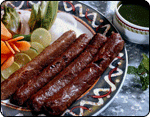Cuisine
 Like various other art forms. the culinary art of Lucknow was also raised to a fine art under royal patronage. A favourite past time of the nobility of Awadh was perfecting the art of cooking. The bawarchis and rakabdars of Awadh, by their expertise of blending spices, achieved a high degree of finesse in cooking and presentation of food that took culinary art to the highest realms. This gave birth to the Dum style of cooking or the art of cooking over a slow fire, which has become synonymous with Lucknow today. The bawarchisof Awadh transformed the traditional dastarkhwan with elaborate dishes like kababs, kormas, kaliya, nahari-kulchas, zarda, sheermal, roomali rotis and warqi parathas. The richness of Awadh cuisine lies not only in the variety of cuisine but also is the ingredients used in creating such a variety. Nahari a hot favourite of Awadh is a meat preparation with thick spicy gravy.
Like various other art forms. the culinary art of Lucknow was also raised to a fine art under royal patronage. A favourite past time of the nobility of Awadh was perfecting the art of cooking. The bawarchis and rakabdars of Awadh, by their expertise of blending spices, achieved a high degree of finesse in cooking and presentation of food that took culinary art to the highest realms. This gave birth to the Dum style of cooking or the art of cooking over a slow fire, which has become synonymous with Lucknow today. The bawarchisof Awadh transformed the traditional dastarkhwan with elaborate dishes like kababs, kormas, kaliya, nahari-kulchas, zarda, sheermal, roomali rotis and warqi parathas. The richness of Awadh cuisine lies not only in the variety of cuisine but also is the ingredients used in creating such a variety. Nahari a hot favourite of Awadh is a meat preparation with thick spicy gravy.
In 'Pai ki Nahari' leg and other bones are cooked and bone juice is mixed with a mouth watering gravy. Nahari was originally a beef preparation eaten with Kulchas . Now-a-days mutton is used instead of beef in houses. The best place where beef Nahari is still served in Lucknow is the Rahim's shop inside Akbarigate which has produced some of the best Nahari dishes for the past five generations. Lucknow is also proud of its Kababs. The Kakori Kababs. Galawat ke Kababs Shami Kababs. Boti Kababs, Patili-ke-Kababs, Ghutwa Kababs and Seekh Kababs are among the known varities. The 100 year old 'Tunde ke Kabab' in chowk is the most famous outlet for choicest Kababs even today. Karma a preparation ofmeat in gravy was an essential item of the Awadh dastarkhwan. 'Biryani' was yet another item cooked in Dum style. The method imparted a typical Awadhi flavour to this rice preparation. The warqi paratha and sheermals are other sumptuous dishes of Lucknow that are simply a gourmet's delight.

